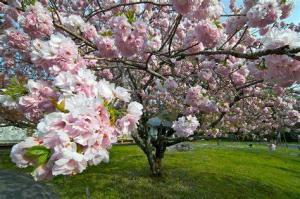He was the first president to throw the first ball of baseball season, the first president to own a car (including an electric Baker Electric car). President Taft was the last president to graze a cow, named Pauline, at the White House. Taft was also the president who started the famous Washington, D.C. cherry blossom festival when on March 27, 1912, his wife Helen Taft and the wife of the Japanese ambassador planted two Yoshino cherry trees on the northern bank of the Tidal Basin, near what is now Independence Avenue SW. This was to honor Japanese and American friendship. The original two Japanese flowering cherry trees still stand several hundred yards west of the John Paul Jones Memorial, located at the end of 17th Street SW.
There are actually several varieties of non-fruiting ornamental cherry trees. Most popular is the Kanzan (Kwanzan) cherry, named after a mountain in Japan. Kwanzan cherry trees bloom with huge double flowers in breathtaking dark pink that completely cover the tree from late April to early May. The trees are just as pretty when not blooming. After the blossoms fade, Kwanzan cherry trees reveal beautiful bark and dark-green leaves. In the fall the leaves change to a stunning mix of copper-red, yellow and orange. Kwanzan flowering cherry is easier to care for than many other flowering cherry trees. Because they only grow 15 to 25 feet tall, they are ideal for smaller yards, along sidewalks or even for planting in tubs or large containers.
Choose a site in full sun or partial shade. The soil should drain easily, so if your dirt is hard, compacted clay, work in a generous amount of compost or even pumice. Soil that gets waterlogged will cause the roots to rot. If the soil is so hard that water runs over it and never sinks in, your tree will die of thirst even in a rainy season. Flowering cherry trees are often grown as a bonsai.
The Kwanzan cherry is perfect for impatient gardeners because they often bloom the first year planted, and are completely covered in flowers from the second year on. They are hardy in USDA Zones 5-9.
Another flowering cherry is the Okame cherry tree, which is one of the first to bloom every year. Okame trees have medium-pink petals that burst open even before leaves sprout.
Even before the buds open, Okame is stunning with brilliant pink buds. This cherry tree blooms for up to three weeks.
The Okame flowering cherry reaches 20-30 feet in height with a similar spread. When young, the trees are nearly straight sentinels, but as they mature they become more rounded. They grow about one to two feet or more each year. The Okame flowering cherry is hardy in USDA Zones 6-9.
One of the most widely planted flowering cherry trees is the Yoshino cherry tree. Yoshino cherry blossoms are white with pink accents. The flowers have a sweet almond fragrance. After blooming, Yoshino trees are quite handsome, with lateral branches in an oriental pattern, shiny bark, and deep, dark green leaves.
Plant Japanese flowering cherry trees, and within two years you will have a stunning springtime tree and armloads of fragrant flowers for bouquets. Let these beautiful immigrants be a reminder that America wouldn't be America without our Asian friends.






















































